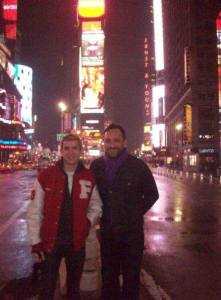
Whether you’re Michael Jordan, Justin Beiber or even former President George W. Bush, no one is exempt from a nomination for the ALS Ice Bucket Challenge.
For the past few weeks, it has overtaken our Instagram and Facebook pages. Most videos are the same: they thank the person who nominated he or she, challenge a few others and finally, get dowsed by a bucket of ice water.
[two_fifth]
When I received two nominations in the same day, I started to question the whole craze. I couldn’t have told you what ALS stands for and I really didn’t understand why dumping a bucket of water on myself brought any awareness to the disease.
Before my 24 hours were up, I looked into the meaning behind the challenge. Amyotrophic lateral sclerosis, also known as Lou Gehrig’s Disease, is a progressive neurodegenerative disease that affects nerve cells in the brain and the spinal cord.
As the disease takes over the body, motor neurons die, and the brain can no longer control muscles. Total paralysis is certain, and generally occurs within 2-5 years of diagnosis.
The challenge benefits the ALS Association, which helps provide care services to people with ALS and their families.
Their global research program focuses on the discovery of treatments and eventually a cure for the disease.
When I took the challenge, I dedicated my experience and donation to an old friend whose father died two years ago after four years of fighting.
Ball State alumni Matthew Amaro has a unique perspective on the Ice Bucket Challenge. Two years ago, his brother, Robert, died of ALS at 49 years old. He went to the doctor after falling numerous times due to muscle failure and was diagnosed in February 2012.
Robert became dependent on an electronic wheelchair and his 24-hour nurse four months later. Because there is no cure for ALS and very little treatment. Robert died September of the same year after going into cardiac arrest.
After watching one of his role models lose his freedom and life to ALS, Matthew sees the ice bucket challenge as a positive trend.
“People are actually hearing and talking about it…I would talk to people about my brother dying from ALS and more often than not had to explain what it was,” Matthew says.

He acknowledges that the challenge has lost some of its meaning by people participating just to avoid making a donation. However, he chooses to give everyone the benefit of the doubt.
“Just because someone didn’t choose to make it known that they were donating doesn’t mean they didn’t,” Matthew said.
When Matthew took the challenge, he dedicated the experience to his late brother.

This trend began with Chris Kennedy in Sarasota, Florida. He was nominated by a friend to take part in this challenge and donate to any charity. He used the opportunity as a platform to give to Lou Gehrig’s disease research in honor of his cousin. Nominations continued until it reached Pete Frates, a former Boston college baseball player who also has ALS. He is credited with the founding of the craze because he nominated Tom Brady, which caused the trend to pickup speed.
Matthew says the point of pouring ice water on yourself is to mimic the feeling of what a person with ALS experiences daily: not extreme cold, but the loss of control of your own muscles while still feeling everything.
The ALS Association reports that they have received $107.4 million in donations this year compared to almost $3 million during the same time period last year, which is just over 30 days. Since this challenge hit social media, the association gained 3 million new donors. While that’s only a small portion of people partaking in the challenge, the numbers are rising exponentially by the week.
“Even though my brother died from this horrible disease, at least many others who will be diagnosed with have a chance,” Matthew says. “And while there is treatment that can slow down progression, there is a quality of life aspect that you have to dwell on as well. We’re looking for a cure.”




